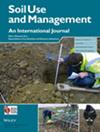蚕豆、蓝羽扇豆和鹰嘴豆获取磷与土壤磷状况的关系
IF 3.7
3区 农林科学
Q1 SOIL SCIENCE
引用次数: 0
摘要
土壤磷(P)的动员效率和植物对磷的吸收取决于复杂的综合因素,包括植物获取磷的策略和土壤磷的可用性。本研究旨在评估和比较三种豆科植物(蓝羽扇豆(Lupinus angustifolius L.)、蚕豆(Vicia faba L.)和鹰嘴豆(Cicer arietinum L.))从具有不同植物可利用态磷水平的土壤中获取态磷的能力。在为期 6 个月的时间里,每种豆科植物都在玻璃温室中生长了三个周期,分别生长在植物可利用钾水平较高(奥尔森钾:47 毫克/千克-1)和较低(奥尔森钾:9 毫克/千克-1)的同一类型土壤中。除了测定酸性和碱性磷酸单酯酶活性、微生物钾和实验结束时土壤中的钾组分外,还测量了地上和地下植物的生物量和钾吸收量。在两种土壤中,与蓝羽扇豆和鹰嘴豆相比,蚕豆的植物生物量、钾吸收量和微生物钾含量都更高(p < .05)。在低磷土壤中,蚕豆提高了碱性磷单酯酶的活性(p < .05)。与蓝羽扇豆相比,蚕豆的可溶性(46%-69%)、易溶性(29%-42%)和中度易溶性(15%-16%)池中的无机钾显著减少,易溶性(13%-18%)和总钾(7%-13%)池中的有机钾显著增加,而鹰嘴豆的变化介于蚕豆和蓝羽扇豆的变化之间(p <.05)。这项研究的结果表明,施用蚕豆绿肥有可能通过提高对土壤中易变无机钾的吸收来提高钾的总体利用效率,但还需要进一步研究土壤中更稳定形式的遗留钾的吸收情况,并量化蚕豆作为绿肥作物在田间条件下的潜力。本文章由计算机程序翻译,如有差异,请以英文原文为准。
Phosphorus acquisition by faba bean, blue lupin, and chickpea in relation to soil phosphorus status
The efficiency of soil phosphorus (P) mobilization and uptake by plants depends on a complex combination of factors, including plant P acquisition strategies and soil P availability. The objective of this study was to assess and compare the capabilities of three legume species (blue lupin (Lupinus angustifolius L.), faba bean (Vicia faba L.), and chickpea (Cicer arietinum L.)), which may be used as green manures in temperate crop systems to acquire P from a soil with different levels of plant‐available P. Three cycles of each legume were grown in a glasshouse over a 6 month period in the same soil type with high (Olsen P: 47 mg kg−1 ) and low (Olsen P: 9 mg kg−1 ) levels of plant‐available P. Measurements included above—and below—ground plant biomass and P uptake, in addition to determination of acid and alkaline phosphomonoesterase activities, microbial P, and P fractions in soil at the end of the experiment. In both soils, plant biomass, P uptake, and microbial P were all higher under faba bean compared to blue lupin and chickpea (p < .05). In the low‐P soil, faba bean increased alkaline phosphomonoesterase activity (p < .05). Significant depletion of inorganic P in the soluble (46%–69%), labile (29%–42%), and moderately labile (15%–16%) pools and increase of organic P in the labile (13%–18%) and total (7%–13%) pools occurred under faba bean compared with blue lupin, while changes under chickpea were between those determined for faba bean and blue lupin (p < .05). The findings of this study indicated that inclusion of faba bean green manure may have the potential to improve overall P use efficiency by enhancing mobilization of labile soil inorganic P, although further research is required to investigate mobilization of more stable forms of soil legacy P and quantify the potential of faba bean as a green manure crop under field conditions.
求助全文
通过发布文献求助,成功后即可免费获取论文全文。
去求助
来源期刊

Soil Use and Management
农林科学-土壤科学
CiteScore
7.70
自引率
13.20%
发文量
78
审稿时长
3 months
期刊介绍:
Soil Use and Management publishes in soil science, earth and environmental science, agricultural science, and engineering fields. The submitted papers should consider the underlying mechanisms governing the natural and anthropogenic processes which affect soil systems, and should inform policy makers and/or practitioners on the sustainable use and management of soil resources. Interdisciplinary studies, e.g. linking soil with climate change, biodiversity, global health, and the UN’s sustainable development goals, with strong novelty, wide implications, and unexpected outcomes are welcomed.
 求助内容:
求助内容: 应助结果提醒方式:
应助结果提醒方式:


